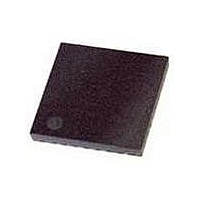WM8976GEFL/V Wolfson Microelectronics, WM8976GEFL/V Datasheet - Page 21

WM8976GEFL/V
Manufacturer Part Number
WM8976GEFL/V
Description
Audio CODECs Mono ADC Stereo DAC with Spkr
Manufacturer
Wolfson Microelectronics
Datasheet
1.WM8976GEFLV.pdf
(111 pages)
Specifications of WM8976GEFL/V
Mounting Style
SMD/SMT
Package / Case
QFN-32
Lead Free Status / RoHS Status
Lead free / RoHS Compliant
Production Data
w
OUT3 and OUT4 can be configured to provide an additional stereo lineout from the output of the
DACs, the mixers or the input microphone boost stages. Alternatively OUT4 can be configured as a
mono mix of left and right DACs or mixers, or simply a buffered version of the chip midrail reference
voltage. OUT3 can also be configured as a buffered VMID output. This voltage may then be used as
a headphone ‘pseudo ground’ allowing removal of the large AC coupling capacitors often used in the
output path.
AUDIO INTERFACES
The WM8976 has a standard audio interface, to support the transmission of data to and from the chip.
This interface is a 3 wire standard audio interface which supports a number of audio data formats
including I2S, DSP/PCM Mode (a burst mode in which LRC sync plus 2 data packed words are
transmitted), MSB-First, left justified and MSB-First, right justified, and can operate in master or slave
modes.
CONTROL INTERFACES
To allow full software control over all features, the WM8976 offers a choice of 2 or 3 wire control
interface. It is fully compatible and an ideal partner for a wide range of industry standard
microprocessors, controllers and DSPs.
Selection between the modes is via the MODE pin. In 2 wire mode the address of the device is fixed
as 0011010.
CLOCKING SCHEMES
WM8976 offers the normal audio DAC clocking scheme operation, where 256fs MCLK is provided to
the DAC and ADC.
A PLL is included which may be used to generate these clocks in the event that they are not available
from the system controller. This PLL uses an input clock, typically the 12MHz USB or ilink clock, to
generate high quality audio clocks. If this PLL is not required for generation of these clocks, it can be
reconfigured to generate alternative clocks which may then be output on the GPIO pins and used
elsewhere in the system.
POWER CONTROL
The design of the WM8976 has given much attention to power consumption without compromising
performance. It operates at very low voltages, and includes the ability to power off any unused parts
of the circuitry under software control, and includes standby and power off modes.
OPERATION SCENARIOS
Flexibility in the design of the WM8976 allows for a wide range of operational scenarios, some of
which are proposed below:
Multimedia phone; High quality playback to a stereo headset, a mono ear speaker or a loudspeaker is
supported, allowing Hi-Fi playback to be mixed with voice and other analogue inputs while
simultaneously transmitting a differential output from the microphone amplifier. A 5-band EQ enables
Hi-Fi playback to be customised to suit the user's preferences and the music style, while
programmable filtering allows fixed-frequency noise (e.g. 217Hz) to be reduced in the digital domain.
Camcorder; the provision of a microphone preamplifier allows support for both internal and external
microphones. All drivers for speaker, headphone and line output connections are integrated. The
selectable ‘application filters’ after the ADC provide for features such as ‘wind noise’ reduction, or
mechanical noise reducing filters.
Digital still camera recording; Support for digital recording is similar to the camcorder case. But
additionally if the DSC supports MP3 playback, and perhaps recording, the ability of the ADC to
support full 48ks/s high quality recording increases device flexibility.
AUXILIARY ANALOGUE INPUTS
An analogue stereo FM tuner or other auxiliary analogue input can be connected to the AUX inputs of
WM8976, and the stereo signal listened to via headphones.
PD Rev 4.4 July 2009
WM8976
21











